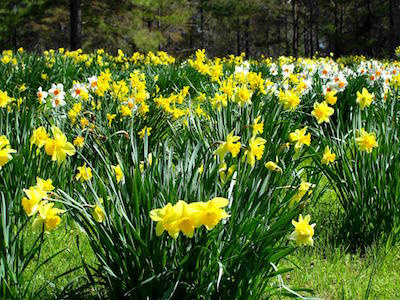
Properly selected daffodils, jonquils, and narcissus provide spring beauty each year.
October 10, 2023 - In East Texas, where the seasons dance to their own beat, gardeners want blooms that endure with grace. Enter the genus Narcissus, a treasure trove of spring blooming bulbs that not only bring timeless beauty but also demand little in return. These long-lived, Earth-Kind bulbs are a gift to our East Texas gardens.
The Narcissus genus includes a vast array of species and cultivars each with its own character. While the classic yellow trumpet daffodils are iconic, there are countless other options to explore including cluster flowered narcissus and dainty jonquils.
The ideal time to plant these bulbs in East Texas is during the fall, generally in October. This allows the bulbs to establish their roots before the arrival of winter.
Narcissus bulbs thrive in well-drained soil and full sunlight. When selecting a location in your garden, ensure it receives at least six hours of sunlight per day. Adequate drainage is essential, as waterlogged soil can lead to bulb rot.
As a general guideline, plant Narcissus bulbs at a depth twice the bulb's height, making sure the nose of the bulb is under the ground. Space the bulbs about 4 to 6 inches apart, giving them room to multiply over the years.
Before planting, amend the soil with organic matter such as compost. This not only improves soil structure but also provides some slow-release nutrients for the bulbs.
Once established, many daffodils, narcissus and jonquils are remarkably low-maintenance and long lived. They are the epitome of Earth-Kind plants as they require no irrigation, nor fertilizer, and no pesticides.
Unlike tulips, these bulbs have the delightful habit of multiplying and returning each year. Although large flowered modern daffodils often need dividing about once a decade, most heirloom narcissus and jonquils continue blooming for centuries. If you’d like to order those types proven to perform well in East Texas, the Smith County Master Gardeners are starting their 25th annual bulb sale on-line tomorrow.
The SCMG webstore (scmg-online.company.site) will open at 7 a.m. on Monday, October 9, and close at 1 p.m. on Wednesday, October 18. Bulbs featured in the sale are all locally trialed and proven performers here. A small selection of new and improved trees and shrubs, along with the new SCMG 2024 calendar and garden guide will be available for pre-order. Anything ordered from the webstore must be picked up between 10 a.m. and 1 p.m., Saturday, October 21 at Pollard United Methodist Church (3030 New Copeland Road, Tyler) immediately after the Bulbs to Blooms conference.
During pick-up hours, there will be a plethora of Smith County Master Gardeners to answer gardening questions; “bonus” bulbs, artwork, and tee shirts for sale; children’s activities, and more helping them celebrate the 25th anniversary of the popular sale and conference.
The Smith County Master Gardeners have worked diligently through the years identifying and making available long-lived, Earth-Kind bulbs that are uniquely adapted to Texas and the South.
For more information visit the Smith County Master Gardener website at https://txmg.org/smith/ or follow them on Facebook. Proceeds from the sale support horticulture education in Smith County, the Tyler Botanical Garden, and scholarships for horticulture students at Texas A&M and Stephen F. Austin State Universities. Smith County Master Gardeners are trained volunteer educators coordinated by the Texas A&M AgriLife Extension Service.
Greg Grant is the Smith County horticulturist for the Texas A&M AgriLife Extension Service. He is the author of Texas Fruit and Vegetable Gardening, Texas Home Landscaping, Heirloom Gardening in the South, and The Rose Rustlers. You can read his “Greg’s Ramblings” blog at arborgate.com and read his “In Greg’s Garden” in each issue of Texas Gardener magazine (texasgardener.com). More science-based lawn and gardening information from the Texas A&M AgriLife Extension Service can be found at aggieturf.tamu.edu and aggie-horticulture.tamu.edu.








